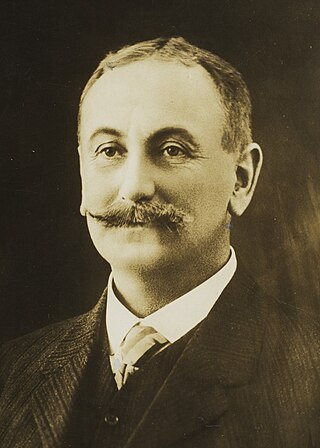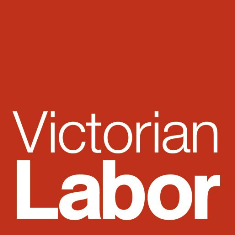Related Research Articles

The Nationalist Party, also known as the National Party, was an Australian political party. It was formed in February 1917 from a merger between the Liberal Party and the National Labor Party, the latter formed by Prime Minister Billy Hughes and his supporters after the 1916 Labor Party split over World War I conscription. The Nationalist Party was established as a 'united' non-Labor opposition that had remained a political trend once the Labor party established itself in federal politics. The party was in government until electoral defeat in 1929. From that time it was the main opposition to the Labor Party until it merged with pro-Joseph Lyons Labor defectors to form the United Australia Party (UAP) in 1931. The party is a direct ancestor of the Liberal Party of Australia, the main centre-right party in Australia.
The Liberal Party was a parliamentary party in Australian federal politics between 1909 and 1917. The party was founded under Alfred Deakin's leadership as a merger of the Protectionist Party and Anti-Socialist Party, an event known as the Fusion.
The National Labor Party was formed by Australian Prime Minister Billy Hughes in 1916, following the 1916 Labor split on the issue of World War I conscription in Australia. Hughes had taken over as leader of the Australian Labor Party and Prime Minister of Australia when anti-conscriptionist Andrew Fisher resigned in 1915. He formed the new party for himself and his followers after he was expelled from the ALP a month after the 1916 plebiscite on conscription in Australia. Hughes held a pro-conscription stance in relation to World War I.

Frank Wilson, was the ninth Premier of Western Australia, serving on two separate occasions – from 1910 to 1911 and then again from 1916 to 1917.

John Scaddan, CMG, popularly known as "Happy Jack", was Premier of Western Australia from 7 October 1911 until 27 July 1916.
The Electoral district of Brown Hill-Ivanhoe was a Legislative Assembly electorate in the state of Western Australia. It covered part of the Goldfields city of Boulder, near Kalgoorlie, and neighbouring mining areas. It was created at the 1911 redistribution out of the former seats of Brown Hill and Ivanhoe, and was first contested at the 1911 election. It was abolished in the 1948 redistribution, with its area split between the neighbouring electorates of Boulder and Hannans, taking effect from the 1950 election. The seat was a very safe one for the Labor Party.

Sir Alexander James Peacock was an Australian politician who served as the 20th Premier of Victoria.

The electoral district of Perth is a Legislative Assembly electorate in the state of Western Australia. Perth is named for the capital city of Western Australia whose central business district falls within its borders. It is one of the oldest electorates in Western Australia, with its first member having been elected in the inaugural 1890 elections of the Legislative Assembly.
The 1918 Swan by-election was a by-election for the Division of Swan in the Australian House of Representatives, following the death of the sitting member Sir John Forrest. Held on 26 October 1918, the by-election led to the election of the youngest person to be elected until 2010 to the Parliament of Australia, Edwin Corboy. It saw the conservative vote split between the Country Party and the Nationalist Party, which directly prompted the introduction of preferential voting in Australia.
The Western Australian National Party, officially known as the National Party of Australia (WA) Inc, and branded as Nationals WA, is a political party in Western Australia. It is affiliated with the National Party of Australia, but maintains a separate structure and identity. Since the 2021 state election, the Nationals have been the senior party in an opposition alliance with the WA Liberal Party in the state parliament.
This is a list of members of the Western Australian Legislative Assembly between the 1914 election and the 1917 election, together known as the Ninth Parliament. The re-election of Premier John Scaddan's Labor Government with a 26-24 majority in 1914 was tempered when, a year later, Labor member Joseph Gardiner's seat was declared vacant on account of his non-attendance and a Liberal was elected in his stead, and Labor became a minority government when on 18 December 1915, Edward Johnston resigned from the Labor Party and became an independent. On 27 July 1916, the Scaddan Ministry was defeated and the Liberals' Frank Wilson became the new premier.
The Electoral district of Subiaco was a Legislative Assembly electorate in the state of Western Australia. The district was named for the inner western Perth suburb of Subiaco, which fell within its borders. It was normally a safe seat for the Liberal Party and its predecessors, but was won on several occasions by Labor in landslide elections.
The Lefroy Ministry was the 13th Ministry of the Government of Western Australia and was led by Nationalist Premier Sir Henry Lefroy. It succeeded the Second Wilson Ministry on 28 June 1917 due to most members of the former Liberal Party, of which the previous Premier, Frank Wilson, had been the leader, pledging allegiance to the new party. The Lefroy Ministry, which was the first Coalition ministry in Western Australia, was also the only Ministry of a non-Labor government to be chosen by caucus.

The New South Wales Labor Party, officially known as the Australian Labor Party and commonly referred to simply as NSW Labor, is the New South Wales branch of the Australian Labor Party (ALP). The branch is the current ruling party in the state of New South Wales and is led by Chris Minns, who has served concurrently as premier of New South Wales since 2023.

The 1917 Victorian state election was held in the Australian state of Victoria on Thursday 15 November 1917 for the state's Legislative Assembly. 51 of the 65 Legislative Assembly seats were contested.

Sydney Stubbs CMG was an Australian politician who served twice in the Parliament of Western Australia: in the Legislative Council from 1908 to 1911, and then in the Legislative Assembly from 1911 to 1947. He was Speaker of the Legislative Assembly from 1930 to 1933, and had been Mayor of Claremont and then Mayor of Perth prior to entering parliament.

The Victorian Labor Party, officially known as the Australian Labor Party and commonly referred to simply as Victorian Labor, is the Victorian state branch of the Australian Labor Party (ALP). Victorian Labor forms the incumbent government in the state of Victoria and is led by Jacinta Allan, who has served concurrently as Premier of Victoria since 2023.
John Henry "Jack" Smith was an Australian politician who was a member of the Legislative Assembly of Western Australia from 1921 to 1936 and again from 1939 to 1943, on both occasions representing the seat of Nelson. He stood for parliament eleven times in total, winning on six occasions.
References
- de Garis, Brian (1991). "Self-Government and Political Parties". In Black, David (ed.). The house on the hill: A history of the Parliament of Western Australia 1832-1990. West Perth: Parliament of Western Australia. p. 90. ISBN 0-7309-3983-9.